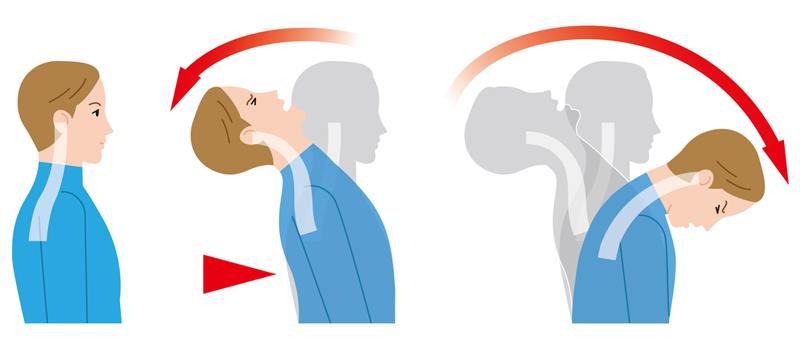Whiplash Symptoms – When to Seek Care
Whiplash is a condition that frequently affects people involved in automobile collisions or other blunt-force trauma events.
It causes a wide range of injuries and symptoms and occurs when a person’s neck is suddenly and abruptly snapped back-and-forth.
How common is whiplash?
Each year, over two million Americans are afflicted with it. Of these, most receive whiplash in a vehicle collision.
If this describes your situation, don’t worry, you’re not alone. According to the Washington State Department of Transportation, there were over 86,230 crashes in the state of Washington in 2020 — and that was just during 2020!
Other sources of whiplash include falling, assault, blunt-force trauma, and high-impact sports like football and snowboarding.
Whiplash is common, which means trusted medical and chiropractic techniques are readily available to help you recover.
In this blog post, we’ll give you the information you need to determine if you’ve experienced whiplash and what you can do about it.
Let’s get started…
What is whiplash?
Whiplash occurs when the neck is whipped backward and then forward during a vehicle collision or other physically-jarring experience.
While the term “whiplash” is used to describe the impact experience, the injuries it can cause have more serious names, including:
• Pulled muscles and ligaments in the neck
• Irritated and damaged nerves
• Injured bones in the spine
• Disc bulges and herniation
The sudden back and forth neck snap that occurs during a rear-end collision (or other traumatic events) strains the ligaments and tendons in your neck, chest, and back. This straining can result in the injuries listed above and lead to the symptoms listed below.
Whiplash affects everyone differently, and the symptoms vary greatly. Depending on the severity of your injury, you could receive minor symptoms like soreness in your neck or severe symptoms like vertigo and depression.
Even if your collision seemed mild and you don’t think the impact was severe enough to injure you, it is still essential to check for whiplash symptoms. If left untreated, even a minor injury can lead to complications.
How long does whiplash last?
With some whiplash incidents, neck pain will disappear between a few days and three months of the event.
Unfortunately, this isn’t true for everyone, as recent studies show that 12-50% of whiplash victims will still be suffering from neck pain over a year after their trauma experience.
MOST COMMON WHIPLASH SYMPTOMS
To help you determine whether or not you have received whiplash, here is a list of the most common symptoms:
• Stiffness and pain in the neck and shoulders
• Headache
• Numbness in the hands, neck, or shoulders
• Arm pain
• Jaw pain
• Fatigue
• Inability to move or fully turn the head
• Visual disturbances
• Ringing in the ears
• Dizziness and vertigo
• Upper and lower back pain
• Depression or abnormal mood changes
• Coordination or balance problems
To help you understand how these symptoms occur and how they affect you, let’s explore a couple of the most frequent symptoms in more detail.
NECK PAIN AFTER CAR ACCIDENT
Neck pain is the most common whiplash symptom, and fortunately, for most victims, this neck pain can subside after a few days. Although, as we mentioned above, that timeline isn’t accurate for everyone, symptoms can linger for years if left untreated.
NECK PAIN WHIPLASH SYMPTOMS
There is a strong chance that you will develop this persistent neck pain if you’re experiencing some of these symptoms:
• Your neck pain developed immediately after the event
• Pain can be felt shooting through your arms and fingers
• You’re suffering from neurological symptoms, such as mood swings and memory loss
• Your pain was immediately severe after the event
If any of these symptoms describe your condition, then it is vital that you seek out quality care soon. Left untreated, these issues increase your chances of chronic neck pain, but you will experience recovery much, much sooner with the proper medical and chiropractic work.
HERNIATED DISC INJURIES FROM WHIPLASH
Besides damaging the tissues and tendons in the neck, a severe whiplash can also damage your cervical spine — the portion of your spine that passes through the neck. An injury in this region will often result in a herniated disc.
Herniation occurs when the gel-like center of a spinal disc breaks through the wall of the spine and compresses a spinal nerve. The delicate nature of this injury separates it from the aforementioned neck pain because, unlike general neck pain, which may heal itself, herniated disks require medical treatment to be resolved, most of the time. (There is research to show that disc herniations can heal themselves)
The symptoms of a herniated disc in the cervical spine include:
• Weakened arm muscles
• Pain on or near your shoulder blade
• Numbness along one side of your body
• Difficulty and pain when turning the head
• Muscle spasms
• Tingling or burning sensations
If you are suffering from any of the above symptoms, it is crucial that you seek medical help right away. Your doctor will likely recommend a treatment combination of medication, rest, and physical therapy.
While medication will help ease your pain, chiropractic and/or physical therapy is what will make the most significant impact on your recovery time.
 HOW TO TREAT WHIPLASH
HOW TO TREAT WHIPLASH
Many interventions can help here. Most of them involve some sort of manual therapy mixed with appropriate exercise interventions.
Our Chiropractors here at Tangelo (Portland and Seattle) will find the right mix of manual therapy techniques (whether that be cupping, ART, adjustments, etc.) mixed with exposure to movements on the rehab floor to help gain range of motion back and load the tissue around the symptomatic area to help improve blood flow and decrease pain and tension.
WHEN SHOULD I SEEK CARE?
It is common for whiplash victims to ignore their symptoms, especially since many of them are minor at the onset. Suffice it to say; this is a terrible practice.
Ignoring your aches and pains could lead to more serious conditions as untreated injuries are left to fester and grow.
If you are experiencing any of the symptoms listed above, then it would be in your best interest to stop by a Seattle or Portland Chiropractor today — the sooner after your event, the better.
BENEFITS OF CHIROPRACTIC CARE FOR WHIPLASH
Here at Tangelo, we provide non-invasive chiropractic treatments that can produce powerful results in whiplash victims.
Our delicate procedures are designed to significantly reduce pain while also encouraging your body to heal itself without invasive treatments, like surgery.
Other benefits of chiropractic care include:
• Pain reduction for the entire body
• Drug-free pain relief
• Mitigation of long-term neck and shoulder pain
• Reduction of scar tissue (through movement over time and exercise prescription)
• Reduction of inflammation
To learn more about how chiropractic techniques can help heal your whiplash or to schedule an appointment, contact Tangelo today!


 HOW TO TREAT WHIPLASH
HOW TO TREAT WHIPLASH

